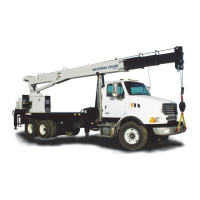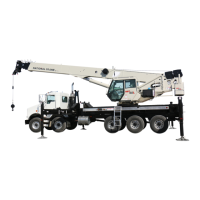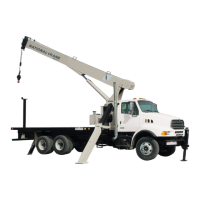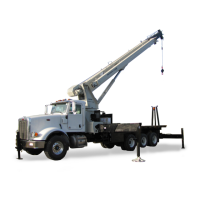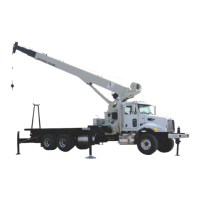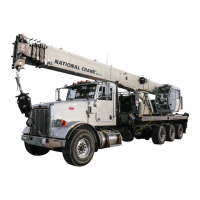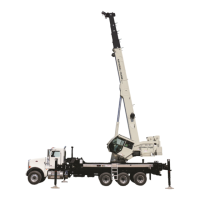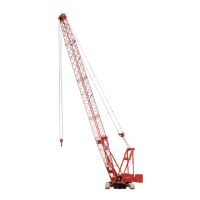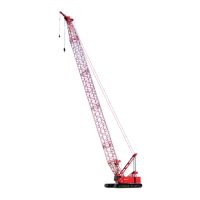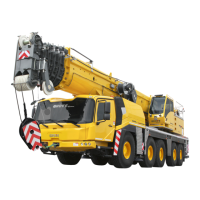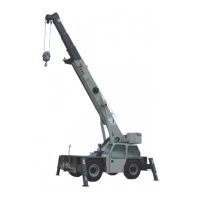OPERATING CONTROLS AND PROCEDURES OPERATOR MANUAL 500E2
3-8 Published 07-26-2019 Control # 111-06
OPTIONAL HOIST BURST OF SPEED (BOS)
The “Burst of Speed” increases hoist line speed 50% over
normal operation by diverting oil from the multi-bank control
valve to the hoist valve.
The “BOS” is engaged by operating the hoist control valve
lever while pulling up on the BOS handle below the hoist
knob. The “BOS” feature should only be operated in a
temporary manner to reduce oil heat build up, prevent truck
PTO overloading, and provide independent operation of the
crane and hoist (normal hoist speed will not decrease when
crane functions are used). If the “BOS” feature is run
continuously or with an overload, damage to the crane or
truck could occur. To start the “BOS” smoothly, first pull up on
the BOS handle then operate the hoist lever. To stop the
“BOS” smoothly, return the hoist lever to its neutral position
then release the BOS handle.
.
ANTI-TWO BLOCK SYSTEM
With untrained or inexperienced or distracted operators, two
blocking the hoist cable is a very real possibility. When the
hoist cable and end attachments contact the underside of the
sheave case, whether by hoisting up or extending the boom
without paying out the hoist cable, the hoist cable can be
damaged by crimping or over tensioning.
The anti-two-block system provided on your National Crane
can help prevent cable damage by sensing the position of
the hoist cable end attachments with respect to the sheave
case and disabling the functions that can cause a two block
condition.
The anti-two-block system consists of normally open, work
port unloader valves in the main and hoist control valves.
When the cartridge solenoid is energized, the crane
functions normally, when de-energized, the oil to the boom
extend, boom down, and hoist up crane functions are
diverted to tank. These solenoids are controlled by a limit
switch, which is attached to the boom or jib sheave case.
This switch is held in the closed position by a chain
suspended weight. The weight, which is looped around the
hoist cable, causes the contacts to remain closed until the
hoist cable end attachments contact the weight and release
the tension on the switch. At this point the contacts in the
switch open, breaking electrical continuity through the circuit
provided by the internal anti-two-block cord routed through
the boom. When this continuity is broken, the unloader
cartridges de-energize and divert the function oil to tank. An
indicator light is provided on the control console to alert the
operator when a two-block condition is detected.
On machines equipped with an optional Rated Capacity
Limiter (RCL) System, the anti-two-block system is integral
with the RCL wiring and display. An audible, visual warning
of the two block condition is provided in the display console.
See RCL Operators Handbook for additional information.
Normal functioning is restored by hoisting down (or retracting
boom) until the weight is once again suspended freely.
Occasionally if the hoist up and boom extend functions are
operated at maximum speed in the dump mode, the back
pressure induced in the circuit will cause the hoist up or
boom extend functions to creep slightly (with no load on the
hook). Such a condition is not cause for alarm, as the back
pressure is not of sufficient magnitude to damage the cable
or end connections.
OUTRIGGER MONITORING SYSTEM (OMS)
(OPTIONAL—STANDARD IN NORTH
AMERICA)
The Outrigger Monitoring System (OMS) aids the operator in
ensuring that the crane is properly setup on outriggers and
stabilizers. The OMS utilizes one sensor in each outrigger
and one proximity switch in each horizontally extending
stabilizer to identify when the outriggers and stabilizer beams
are extended to a point in which they provide maximum
stability.
CAUTION
If the BOS feature Is run continuously or with an overload,
damage to the crane or truck could occur.
BOS
Handle
Note: Maximum Capacity with “BOS”
• One Part Line - 3000 lb (1361 kg)
• Two Part Line - 6000 lb (2722 kg)
• Three Part Line - 9000 lb (4082 kg)
• Maximum line speed on third layer - 271 FPM
(73mpm), fourth layer - 294 FPM (81 mpm)
Hoist Lever

